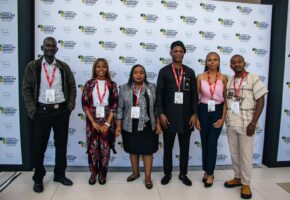Sarah Caven
Building A Frontier Impact Investment Sector – The Path Forward For Artisanal And Small Scale Mining – Part 1
ASM
27 Mar , 2020
The artisanal and small-scale mining (ASM) sector is largely unknown or poorly understood by the finance world. There is a perception held by many that investing in and financing ASM comes with insurmountable risk.
All investing carries risk, especially in new, unproven or complex sectors such as ASM, however, and this barrier is often dismantled over time as pilot projects demonstrate viability and the investment opportunity emerges.
In this continuing series of blog articles, we consider the current status of ASM as an impact investment sector and the barriers it faces. We suggest that building the necessary infrastructure to enable access to finance for ASM can begin to erode these barriers and help to advance ASM projects nearer to unlocking finance.
TDI Sustainability (TDI) and Solidaridad have partnered for this blog series, reflecting on insights gained from a recent research report commissioned by Solidaridad and carried out by the Global Initiative against Transnational Organized Crime; TDI’s own research in this field funded by planetGOLD; and first-hand experience in building The Impact Facility for Sustainable Mining Communities, enabling blended finance solutions for ASM.

Demonstrating a gravity concentration circuit to promote mercury reduction following installation at a TIF mine site in Tanzania on a trial lease to purchase scheme.
Artisanal and Small Scale Mining vs Impact
The impact opportunity in ASM might seem clear to those of us working in the sector. Artisanal and Small-Scale Miners (ASM) constitute a producer sector considered the second largest rural livelihood after agriculture, employing 40 million globally with another 150 million dependents. These enterprises are revenue-generating and have the potential to be an economic catalyst within rural and marginalized communities. Not only that, but they are also supplying materials essential both to the green technology necessary for a sustainable future – from electric vehicles to wind turbines – and to satisfying our luxury demands, from sapphires to smartphones.
The concepts of ‘mining” and “Impact” however are simply not an obvious fit in the minds of most impact investors. It is not surprising that when this dissonance is combined with the many perceived barriers to investing that ASM remains largely overlooked by impact investors.
We found that many of the barriers and challenges to investment in ASM could be clustered into impact investor risk categories as defined by the Global Impact Investor Network (GIIN). The risks uncovered by our research were predominantly found to fall into the themes of:
- Lack of track record in project management and execution;
- Perception and reputational risk; which often overlap with
- Environmental, social and governance (ESG) risk.
These barriers were also found to be significant by others researching this area, including those articulated in the previous Solidaridad blog post and research, and other recent publications by SDMR and the PPA study by Sofala Partners and BetterChain.
One of the commonly overlooked barriers however, is ASM’s newness as an impact investment sector. This is an opportunity to enable flows of impact capital to a traditionally marginalised group.
The Justification for Impact Capital
Impact investment in ASM is an opportunity to address an underserved sector in parallel with incentivised ESG improvements.
ASM needs access to finance in order to realize economically sustainable business growth in parallel with environmental, social and governance improvements. With the right kinds of finance and support structures in place, the ASM sector could realize tangible impacts at both an enterprise and community level.
Currently, ASM continues to rely on informal finance, this provides no incentive for ESG improvements, such as mercury reduction and elimination. Banks are reluctant to lend to ASM, given the perceived risk and lack of understanding of these types of enterprises. As a result, ASM is largely left with only one other option – donor and grant finance. While this type of funding is important in many contexts, its main objectives are often ESG improvements rather than business-led solutions.
Impact investment offers the best of both worlds however, incentivising ESG improvement grounded in viable economic enterprises. Engaging impact investment is also the natural next step in building this frontier investment sector with the hope that one day ASM enterprises can access domestic financial services like any other small producer.
As long as ASM continues to be viewed solely as a development challenge it is unable to graduate to other sources of formal finance, such as impact investment, to grow and improve its business operations. As one miner stated:
“We don’t need charity, we are literally sitting on gold. We just need someone to help us get it out of the ground”
~ Uganda, Lake Victoria Gold Program, the Impact Facility.
So how can we diversify from donor and grant funding, and enable ASM enterprises to progress towards economically self-sufficient, responsible small and medium-sized enterprises? And how might we unlock opportunities for impact investment along the way?
ASM is “New” to Impact Investors
The Impact Facility (TIF) has found the lack of current impact investment is not necessarily due to a fundamental institutional barrier. Rather, ASM is a new impact investment sector held back by unfamiliarity and lack of enabling market infrastructure – the structures, entities and processes which enable investment in new investment sectors. Some impact investors have even reviewed projects and have indicated their interest to engage in the future.
To understand how ASM may evolve as a new impact investing sector, and how this evolution can be better understood and facilitated, this blog provides an overview of the following and applies them to the ASM context:
- Risk vs Reward
- The Curve of Adoption
- The Impact Investment Continuum
Opening up ASM as a new impact investing sector, as challenging as it may be, is an opportunity to enable increased flows of impact capital to currently underserved regions in South Asia and Sub Saharan Africa. Further discussion on unlocking access to finance for ASM can be found in the full planetGOLD report or on the Impact Facility’s (TIF’s) approach to ASM investment through the Impact Facility website.
Risk Vs Reward – Crossing The Threshold
Impact investors will consider a possible investment in terms of risk and reward. Typically high risk projects must offer high reward or demonstrate they can manage and mitigate risk to reduce it to a level that is attractive.
Right now, ASM is generally perceived as high risk and low reward. Therefore this exciting frontier sector will struggle to compete with other established and proven impact investing sectors such as agriculture and energy, which secure large portions of impact capital.
But ASM is not necessarily special in this regard. Impact investors can be generally risk averse, not just when it comes to ASM.

ASM projects perceived as high risk high reward (1) must demonstrate they can reduce or manage risk (2.b) and/or maximise rewards (2.a) relevant to impact investors to compete with other impact investing opportunities.
This is evidenced by results of the Global Impact Investor Network (GIIN) survey, which revealed 66%, target market rates of return, often not possible with new sectors, and less than 20% of assets under management are located in Sub Saharan Africa and South Asia, generally seen as higher risk regions, the home of 67% of ASM workers.
Despite this, a few impact investors have committed funds to ASM. They have a higher tolerance for risk and place greater emphasis on the reward generated by striving to generate impact in unchartered territory among otherwise marginalized communities or sectors.
The Curve Of Adoption – Identifying Investors Most Likely To Engage
According to the curve of adoption, any new product or service that comes to market takes time to be accepted. We have applied this to investing in ASM. Different investors are motivated by different things and will, therefore, behave in different ways. Investors who adopt new sectors first are termed innovators; they are visionary and creative with high risk tolerance. Those who follow innovators are termed early adopters; they are motivated by the opportunity to secure a competitive or strategic advantage and reinvent the mainstream. The easiest path to securing investment at the current stage of the ASM sector’s maturity is to identify and work with the innovator and early adopter impact investors.

The curve of adoption applied to ASM: A new product or service will be adopted over time. At its current stage of development, ASM will appeal more to impact investors who are willing to be innovators or early adopters, excited by the frontier investment opportunity. (Read more here)
Given the complex nature and early maturity stage of the ASM impact investing sector, impact investors require expert knowledge and boots on the ground in order to invest. This may not appeal to the majority but some are already investing, these are the innovators.
“Investing into ASM presents an opportunity for substantial social and economic impact, a rare chance for local communities to directly benefit from their natural, geological resources. Yet, investing into ASM is unlike any other commodity with unique and significant risks which require far greater hands-on, specialized investment management.” ~ Matthew Chambers, Chair, Chambers Federation
Some foundations and impact investors are actively reviewing ASM projects, but have requested analytical tools and data on investment returns and impact to present to investment committees. These may be early adopters. Evidence indicates that many investors are waiting for proof of concept, data, tools and resources and a value chain with investable businesses that can enable more equitable distribution of capital, generating impact and returns.
The majority of impact investors will only seriously consider this impact investing opportunity when there is a sufficient data-based track record of financial and impact metrics, the sector has been proven to be sufficiently de-risked and investment at a larger scale is possible given many have a minimum investment size in the region of millions of dollars.
The Investment Continuum – Building A New Impact Investing Sector
Building a new impact investment sector takes time and requires donor and grant money followed by risk-tolerant impact capital, to build the infrastructure necessary to enable others to follow. This timeline can be explained using the investment continuum. This continuum is essentially a road map to demonstrate how a new sector can build over time with different types of finance driven by different purposes.

Building ASM as a new impact Investment Sector will require 1) the building of infrastructure to make enterprises investment ready, 2) innovators to design investment-led programs and prove their viability as commercial and impactful investment opportunities, and 3) market scalers to enable positive impact across the ASM sector at a global scale. Read more on Embracing the Full Investment Continuum and Allocating for Impact.
Building and de-risking frontier investment sectors can take several decades, but is not impossible. Other sectors and initiatives in impact investing have emerged and scaled to become mainstream, such as the microfinance sector and renewable energy. Gender lens investing is following as it garners increasing interest and momentum. Most recently Refugee investing has emerged. It may be feasible for the ASM sector to follow these sectors, learning where possible from their experiences, to dismantle barriers to impact investment, de-risk and become more broadly “investable”.
Right now we are in the market infrastructure building phase. Market infrastructure builders, in this sector, include social ventures and donor-funded programs developing tool kits and investable ASM opportunities such as the Impact Facility and Barksanem, and innovator impact investors and donors funding these efforts. Efforts of such programs, in parallel with more pioneering donor and grant programs facilitating investment-led solutions, will pave the way for new investors and eventually investment at scale. The longer term vision being that a responsible ASM enterprise will be able to access a bank loan like any other small or medium sized enterprise.
Joint Cooperation Towards Responsible Asmf
The Impact Facility is building an ecosystem for change. At its heart is the design of blended finance solutions for ASM with the vision to scale across geographies and commodities. It works with ASM groups, donors, NGO and private sector partners and investors. To date, the Impact Facility has trialled ‘pay per use’ and ‘lease to purchase’ asset financing in East Africa, alongside capacity strengthening programs in gold, cobalt and gemstones, working with market partners to build solutions that will enable sustained change among artisanal and small scale mining communities while growing global supply of responsibly sourced minerals.
This blog is based on the experiences of the Impact Facility and TDI’s research “Unlocking Finance for ASGM” funded by planetGOLD. Please get in touch with any thoughts or feedback on this blog or, if you would like to learn more about the Impact Facility and ASM.
In our next blog, we look at some actions that can be taken on a sector and project level to move ASM along the Impact Investing Continuum.
Additional Reading:
- Read TDI’s planetGold funded research paper.
- Find out more about the work of The Impact Facility.
- Read about the Solidaridad gold programme.
- Find out more about planetGOLD.





